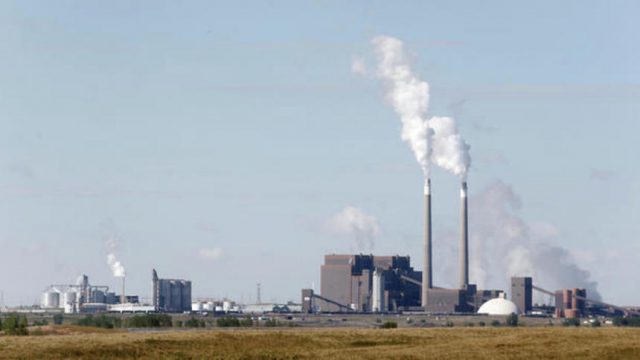If We Want Electric Vehicles We’re Going to Need Coal Power Which Is Why the Coal Industry Is Backing Them

Great River Energy's Coal Creek Station on Wednesday, August 19, 2015, in Underwood, N.D. (Logan Werlinger/Grand Forks Herald)
There are still a lot of things which need to happen before electric vehicles become, for most of us, anything more than an expensive novelty.
As a tech enthusiast, there are a lot of things about electric cars which are downright thrilling. Like the self-driving capabilities, which have now proliferated to the point where people sleeping in their autopiloted Teslas has become a problem. While you shouldn’t be sleeping behind the wheel, that we have cars now that can drive themselves to that degree is amazing.
I mean, my grandmother could remember her father taking her to school in a wagon drawn by horses. We’ve come a long way.
There are other, less geeky advantages to electric vehicles too. At present prices, using electricity is cheaper than gasoline. Maintenance costs are generally cheaper, too.
But there are still problems.
Charging an electric vehicle takes a long time, even at the charging stations which are specifically designed to power them up quickly. The standard Tesla Model 3 has a range of about 240 miles in regular driving conditions. That means I couldn’t drive from my home in Minot to Fargo without stopping somewhere along the route to charge.
[mks_pullquote align=”right” width=”300″ size=”24″ bg_color=”#ffffff” txt_color=”#000000″]Coal is cheap. Coal is plentiful. Coal is reliable. Coal is cleaner today, as an energy source, than any other time in its history.[/mks_pullquote]
Even at a charging station, a full recharge would take me about an hour, and there aren’t exactly a lot of EV charging stations in North Dakota. Also, during our bitterly cold winters, EV vehicle batteries simply aren’t going to perform as well as they do in warmer conditions, meaning things like range and charge time will be worse during the months when we most need our vehicles to be reliable.
Right now I can drive my gas-powered SUV to Fargo and most of the way back on one tank of gas. A re-fill takes me maybe 10 minutes. These things remain pretty much the same no matter the temperature outside.
For most of us using an electric vehicle as our primary means of transportation is simply not workable as things stand now.
It won’t always be that way. With technology improving rapidly, improving charge times and range, I believe electric vehicles have a bright future in America, but that potential is tempered by what we’re doing to our electrical grid.
This week a group called Drive Electric North Dakota is holding a public forum in Bismarck to discuss the proliferation of electric vehicles in North Dakota and the public policy questions around it.
DEND represents a coalition of interests, but it might surprise you to learn that the most prominent group is the Lignite Energy Council.
That’s right, North Dakota’s coal industry. If you call the phone number listed on DEND’s website, you’re going to be talking to someone at the LEC.
At first blush it might seem odd to see the coal industry championing something like electric cars, but it makes sense if you consider it. Electric cars represent a vast new market for the product the coal industry produces. As more people adopt electric cars, demand for electricity will increase.
On present trajectories that will almost certainly happen, which makes what’s happening to our electric grid all the more troubling.
Over the weekend reporter John Hageman published a profile of the increasing rancor around wind energy development in our state. While there are a lot of things driving it, a big part of the growing resentment toward wind energy is that it’s displacing reliable, baseline energy sources like coal in the electrical markets.
And that’s happening at a time when demand for electricity could skyrocket as electric vehicles increase their market share.
It doesn’t make any sense. A huge amount of the energy consumed in the United States is in the form of liquid fuel. Over the next decade or so we could see a significant chunk of that consumption switch to the electrical grid. A grid that is, increasingly, dependent on intermittent energy sources like wind.
Coal is cheap. Coal is plentiful. Coal is reliable. Coal is cleaner today, as an energy source, than any other time in its history.
If we continue to promote misguided public policy which drives coal out of the energy markets, we’re curbing our potential when it comes to things like electric vehicles.




